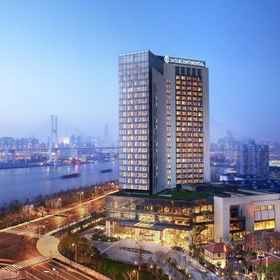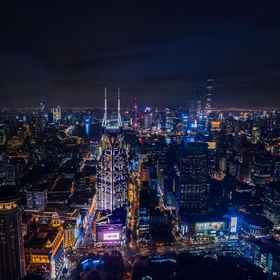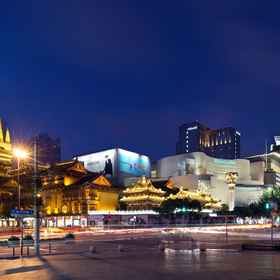
Hotels in China
Popular Hotels in China
Discover what you like
Destinations to Discover







More about hotels China
China is one of the world's four ancient civilisations, and the written history of China dates back to the Shang Dynasty (c. 1600–1046 BC), over 3,000 years ago. Pre-1600 BC, China is charted mainly by legends and prehistoric evidence. The ancient China era was c. 1600–221 BC. The imperial era was 221 BC – 1912 AD, from China's unification under Qin rule until the end of the Qing Dynasty, the Republic of China era was from 1912 until 1949, and the modern China era from 1949 until the present day.
Chinese civilisation began along the Yellow River in the Shang era and spread from there when Bronze Age culture reached its peak. Then, traditional Chinese philosophies, such as Confucianism and Daoism, developed in the feudal Zhou era as China expanded in territory and population. Ancient China finally fractured into warring kingdoms for 200 years, and its reunification marked the start of the imperial China age. The Shang Dynasty was the first to have historical records remaining. Many bronze objects and jade articles, which date back to 1600 BC, have been found to support these early archaeological records. The earliest form of Chinese writing – oracle bones – was found. The inscriptions on animal bones had pictographic characters. The Shang Dynasty’s capital was Yin (Anyang), and its territory stretched between the lower reaches of the Yellow and Yangtze rivers.
After the Shang era, the larger Zhou era territory was divided by a network of feudal states and was ruled over by kings. The king of Zhou only had direct control over a small portion of the realm and received tributes from the feudal states. The first part of the Zhou era was called the Western Zhou (1045–771 BC). It was a fairly peaceful time but, after 770 BC, the Zhou king lost his authority, and seven prominent states emerged.
This era was divided into three periods: the Western Zhou Dynasty (1045–771 BC); the Spring and Autumn Period (770–476 BC), and the Warring States Period (475–221 BC). It marked the transition from tribal society to feudal society. Major philosophies and religions emerged that was the basis of Chinese beliefs in later eras, such as Confucianism and Daoism.
From the first centralised feudal empire, the Qin Dynasty, which was established in 221 BC, until the collapse of the Qing Dynasty in 1912, this period is known as the imperial era of China. The imperial China period makes up the bulk of Chinese history. With the cyclical rise and fall of dynasties, Chinese civilisation was cultivated and prospered in times of peace, then reformed after rebellions and conquests.
The Qin and Han dynasties were the initial period of the Chinese empire. During this period, some institutions were established that laid the foundation of the basic political system for the next 2,000 years. The short-lived Qin Dynasty was the first to unite China as a country under an emperor instead of a ruling clan. A bureaucratic government was introduced and was continued by the less extreme Han Dynasty.
The First Emperor — Qin Shi Huang was the first to use the title of emperor in China. He and his Qin state united China by conquering the other warring states, and he ruled with an iron fist. Qin Shi Huang centralised the power of the empire after he took the throne and set up a system of laws. He standardised units of weight and measurements, as well as the writing system.
The Qin Dynasty was the first and shortest imperial dynasty in China. It was famous for great building projects, such as the Great Wall and the Terracotta Army, which guarded the First Emperor’s burial objects and was to protect him in his afterlife. During the later period of the Qin Dynasty, Liu Bang, a peasant leader, overthrew the unpopular Qin regime and established the Han Dynasty.
The longest imperial dynasty, the Han Dynasty, was known for starting the Silk Road trade and connecting China with Central Asia and Europe. In the Han Dynasty, a bureaucratic system in which promotion was based on merit was established, and Confucianism was adopted by the state for national governance. What’s more, agriculture, handicrafts, and commerce developed rapidly. During the reign of Emperor Wudi (r. 140–87 BC), the Han regime prospered most. The multiethnic country became more united during the Han regime.
The Han Dynasty was one of the most powerful and important dynasties in China’s history. It had far-reaching impacts for every dynasty that followed it. When the Han Dynasty fell into decline, it fractured into the Three Kingdoms Period (220–265). After the Three Kingdoms Period came to the Jin Dynasty, which then conquered most of China (265–420). Its hold on power was tenuous, however, and China again fractured, this time into the Southern and Northern Dynasties (420–589). During this messy time, many religions emerged, and Buddhism was popular among the barbarian kingdoms in North China. After almost 400 years of chaos ended, the Sui Dynasty eventually unified China again in 581 AD.
China's Middle Ages saw steady growth through a series of regime changes. China went from having four warring kingdoms to being the most culturally sophisticated and technologically developed nation. Finally, it was consumed by the rise and fall of the phenomenal Mongol Empire, which stretched to Europe.
In 581, Yang Jian usurped the throne in the north and, as Emperor Wen, united the rest of China under the Sui Dynasty. It was a short, intense dynasty, with great conquests and achievements, such as the Grand Canal and the rebuilding of the Great Wall. One of Emperor Wen’s most prominent achievements was to create the imperial examination system to select talented individuals for bureaucratic positions. Most of this dynasty’s government institutions were adopted by later dynasties. It's considered, along with the following Tang Dynasty, to be a great Chinese era.
After the short-lived Sui Dynasty, the powerful and prosperous Tang Dynasty unified China once again. The Tang Dynasty continued with the Sui’s imperial examination system and optimised it. It ruled for three centuries, and it was also the golden age for poetry, painting, tricoloured glazed pottery, and woodblock printing. In the middle of the Tang Dynasty, an immense rebellion appeared, and some regions refused to follow the state’s authority. This situation continued to the end of the Tang Dynasty.
After the Tang Dynasty came half a century of division in the Five Dynasties and Ten Kingdoms Period (907–960), this ended when one of the northern kingdoms defeated its neighbours and established the Song Dynasty.
The Song Dynasty unified the Central Plain and Southern China. However, the territory under the Northern Song Dynasty’s (960–1127) control was smaller than the Tang Dynasties. The modern-day northern Hebei Province was occupied by the Khitan and was under the control of the Liao Dynasty (907–1125). In the northwest, the Western Xia Dynasty (1038–1227) – ruled by the Tanguts – controlled the modern-day Gansu and northwestern Shaanxi.
Until the first half of the 12th century, the Jurchens (ancestors of modern-day Manchus) annihilated the Liao Dynasty and invaded the Northern Song’s capital. Then the Song government moved and reestablished the capital in Hangzhou, establishing the Southern Song Dynasty (1127–1279). The Jurchens established the Jin Dynasty at the Yellow River Basin until it was conquered by the Mongols in 1271. The Song era was a period of technological advances and prosperity. During the Song Dynasty, the handicraft industry, as well as domestic and foreign trade, boomed. Many merchants and travellers came from abroad. The "four great inventions" of the Chinese people in ancient times (paper, printing, the compass, and gunpowder) were further developed in the Song Dynasty. Since the founding of the People's Republic of China in 1949, China has entered a Communist era of stability, with the Reform and Opening Up policy of 1978 bringing in China's phenomenal economic growth.
In China the climate varies radically, so a decision about the best time to visit should be based on the regions you plan to tour and the kind of weather you enjoy. Autumn is normally the most comfortable season of the year (September to early October). During that period, temperatures are reasonable throughout China (about ten till 22 degrees Celsius, 50-72 degrees Fahrenheit) with a limited amount of rain. Spring roughly has the same average temperatures as autumn.
Summer (from June to the end of August) can be extremely hot with temperatures well above 25 degrees (77° F). Summer is also a rainy season in China. Winter can be incredibly cold especially in the north. Visitors are advised to do thorough research before travelling as the weather for every region is different.
As of 2018, the current population of China is 1,417,363,179 as of Sunday, December 2, 2018, based on the latest United Nations estimates. China population is equivalent to 18.54% of the total world population. China ranks number 1 in the list of countries (and dependencies) by population.
The population density in China is 151 per Km2 (390 people per mi2). The total land area is 9,388,211 Km2 (3,624,807 sq. miles) where 59.3 % of the population is urban (838,818,387 people in 2018). The median age in China is roughly 37 years old. The current male population is now at 51.9% which makes around 727 236 532 males whereas the current female population is now at 48.1% which makes around 673,498,108 females.
How to Get There?
By Flight
The tourists who come from Singapore will have to travel there by plane. They can take a flight at the Changi Airport. The ticket price is around SGD 132 to SGD 300, depending on which part of China they are heading. Peak seasons like a public holiday and school holiday season will surely hike the price. Once they have arrived, they can take a taxi and head straight to their hotel.
What to Do There?
The Great Wall of China
One of the iconic symbols of China, the Great Wall is the longest wall in the world, an awe-inspiring feat of ancient defensive architecture. Its winding path over the rugged country and steep mountains take in some great scenery. It deserves its place among "the New Seven Wonders of the World" and the UNESCO World Heritage Sites in China. The wall spans from China's western frontier to the east coast, totalling around 5,000 km (3,100 miles), but the most integrated and best-preserved sections are close to Beijing. So this is what people usually mean when mentioning the Great Wall of China.
Li River
The karst landscape along the Li River has captured the heart of artists. Generations of Chinese painters and poets have been inspired by the beauty of nature there, using their pens and brushes to capture the breath-taking natural scenery. Nowadays it's a popular photography destination. When Chinese travellers seek a place for natural beauty, they first think of Li River and Yangshuo. The 83-kilometre-long section of the Li River between Guilin and Yangshuo is the most beautiful. The river landscape is decorated with startling hills, cliffs, and farming villages, and is lined with bamboo groves. The Li River was listed as one of the "World's Top Ten Watery Wonders” by America's National Geographic Magazine. Several world famous figures have visited the Li River including former US Presidents Bill Clinton and George Bush (senior), and Bill Gates.
Where to Stay?
Shangri- La Hotel
The award-winning Shangri-La Hotel, Beijing, encompasses the best of China’s dynamic capital city in a serene, luxurious sanctuary. Fabulous dining choices, a 3,000sqm garden, and CHI, The Spa are just some of the facilities and amenities that make the hotel favoured by discerning travellers from around the world. Shangri-La Hotel has several branches all over China.
Sheraton Shenzhen Futian Hotel
Situated in the heart of Shenzhen’s business and shopping district, Sheraton Shenzhen Futian Hotel offers appointed rooms and suites with numerous amenities and services. The hotel has 354 well-appointed guest rooms, a diverse range of stylish restaurants and up to 8,000 square meters of function space. It is directly accessible by MTR, only 5 minutes walk from Shenzhen Convention and Exhibition Center, 10 minutes walk from Futian Station and 10 minutes drive from Futian Checkpoint. Staying with us is a wonderful way to discover the glamour of Shenzhen.
Facts about hotel in China
Total Accommodation | 20 Properties |
Popular Region | Shanghai, Beijing |
Popular Hotel | Kimpton QIANTAN SHANGHAI by IHG, an IHG Hotel, Grand Hyatt Shanghai |
Frequently asked questions

Guest reviews hotel in China
Why book Accommodation in Traveloka?



We’ve got more than just hotels
What interests you?


































 Facebook
Facebook Instagram
Instagram TikTok
TikTok Youtube
Youtube Telegram
Telegram